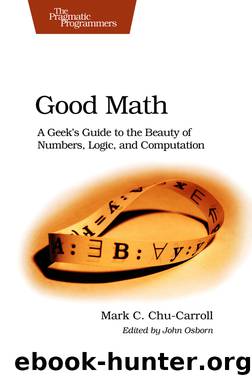Good Math (for Jan S Morrison) by Mark C. Chu-Carroll

Author:Mark C. Chu-Carroll
Language: eng
Format: epub
Tags: Pragmatic Bookshelf
ISBN: 978-1-937785-33-8
Publisher: The Pragmatic Bookshelf, LLC (436473)
That’s really the heart of set theory: set membership and the linkage with predicate logic. It’s almost unbelievably simple, which is why it’s considered so darned attractive by mathematicians. It’s hard to imagine how you could start with something simpler.
Now that you understand how simple the basic concept of a set is, we’ll move on and see just how deep and profound that simple concept can be by taking a look at Cantor’s diagonalization.
16.2 Cantor’s Diagonalization
The original motivation behind the ideas that ended up growing into set theory was Cantor’s recognition of the fact that there’s a difference between the size of the set of natural numbers and the size of the set of real numbers. They’re both infinite, but they’re not the same!
Cantor’s original idea was to abstract away the details of numbers. Normally when we think of numbers, we think of them as being things that we can do arithmetic with, things that can be compared and manipulated in all sorts of ways. Cantor said that for understanding how many numbers there were, none of those properties or arithmetic operations were needed. The only thing that mattered was that a kind of number like the natural numbers was a collection of objects. What mattered is which objects were parts of which collection. He called this kind of collection a set .
Using sets allowed him to invent a new way of defining a way of measuring size that didn’t involve counting. He said that if you can take two sets and show how to create a mapping from every element of one set to exactly one element of the other set, and if this mapping didn’t miss any elements of either set (a one-to-one mapping between the two sets), then those two sets are the same size. If there is no way to make a one-to-one mapping without leaving out elements of one set, then the set with extra elements is the larger of the two sets.
For example, if you take the set {1, 2, 3}, and the set {4, 5, 6}, you can create several different one-to-one mappings between the two sets: for example, {1 ⇒ 4, 2 ⇒ 5, 3 ⇒ 6}, or {1 ⇒ 5, 2 ⇒ 6, 3 ⇒ 4}. The two sets are the same size, because there is a one-to-one mapping between them.
In contrast, if you look at the sets {1, 2, 3, 4} and {a, b, c}, there’s no way that you can do a one-to-one mapping without leaving out one element of the first set; therefore, the first set is larger than the second.
This is cute for small, finite sets like these, but it’s not exactly profound. Creating one-to-one mappings between finite sets is laborious, and it always produces the same results as just counting the number of elements in each set and comparing the counts. What’s interesting about Cantor’s method of using mappings to compare the sizes of sets is that mappings can allow you to compare the
Download
This site does not store any files on its server. We only index and link to content provided by other sites. Please contact the content providers to delete copyright contents if any and email us, we'll remove relevant links or contents immediately.
Algorithms of the Intelligent Web by Haralambos Marmanis;Dmitry Babenko(8587)
Test-Driven Development with Java by Alan Mellor(7555)
Data Augmentation with Python by Duc Haba(7446)
Principles of Data Fabric by Sonia Mezzetta(7207)
Learn Blender Simulations the Right Way by Stephen Pearson(7134)
Microservices with Spring Boot 3 and Spring Cloud by Magnus Larsson(6956)
RPA Solution Architect's Handbook by Sachin Sahgal(6358)
The Infinite Retina by Robert Scoble Irena Cronin(6069)
Hadoop in Practice by Alex Holmes(6055)
Jquery UI in Action : Master the concepts Of Jquery UI: A Step By Step Approach by ANMOL GOYAL(5911)
Big Data Analysis with Python by Ivan Marin(5833)
Life 3.0: Being Human in the Age of Artificial Intelligence by Tegmark Max(5447)
Pretrain Vision and Large Language Models in Python by Emily Webber(4792)
Infrastructure as Code for Beginners by Russ McKendrick(4566)
WordPress Plugin Development Cookbook by Yannick Lefebvre(4278)
The Age of Surveillance Capitalism by Shoshana Zuboff(4192)
Functional Programming in JavaScript by Mantyla Dan(4168)
Embracing Microservices Design by Ovais Mehboob Ahmed Khan Nabil Siddiqui and Timothy Oleson(4059)
Applied Machine Learning for Healthcare and Life Sciences Using AWS by Ujjwal Ratan(4041)
